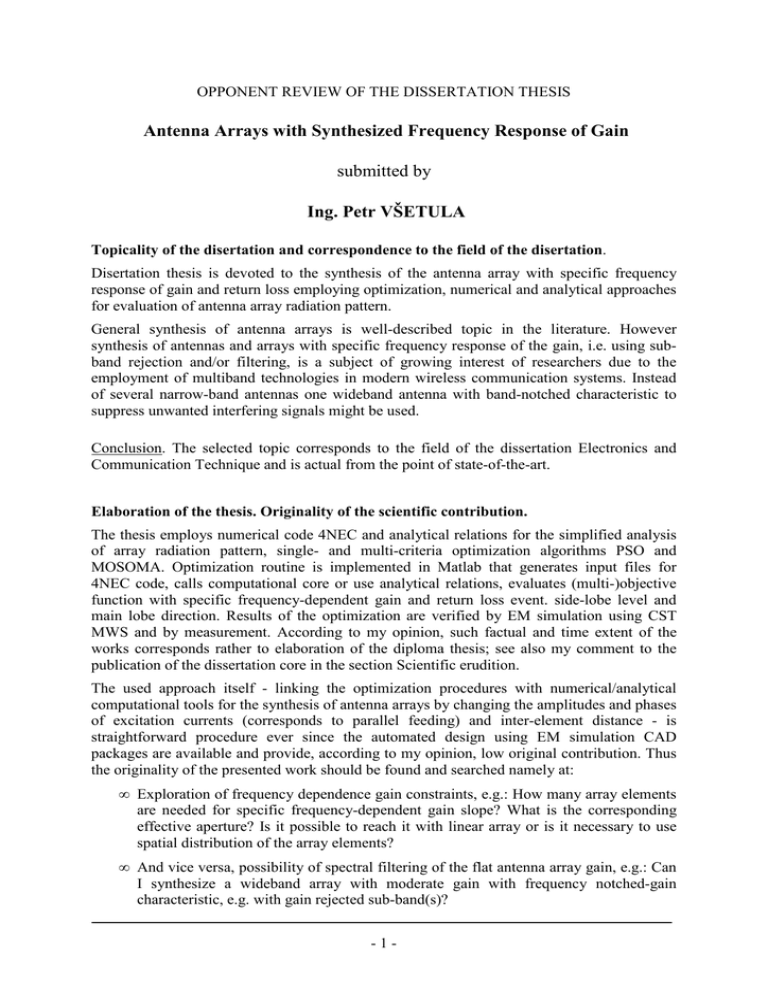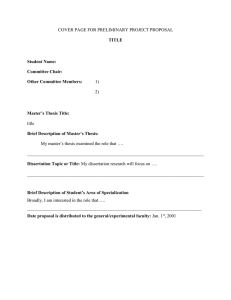Antenna Arrays with Synthesized Frequency Response of Gain
advertisement

OPPONENT REVIEW OF THE DISSERTATION THESIS Antenna Arrays with Synthesized Frequency Response of Gain submitted by Ing. Petr VŠETULA Topicality of the disertation and correspondence to the field of the disertation. Disertation thesis is devoted to the synthesis of the antenna array with specific frequency response of gain and return loss employing optimization, numerical and analytical approaches for evaluation of antenna array radiation pattern. General synthesis of antenna arrays is well-described topic in the literature. However synthesis of antennas and arrays with specific frequency response of the gain, i.e. using subband rejection and/or filtering, is a subject of growing interest of researchers due to the employment of multiband technologies in modern wireless communication systems. Instead of several narrow-band antennas one wideband antenna with band-notched characteristic to suppress unwanted interfering signals might be used. Conclusion. The selected topic corresponds to the field of the dissertation Electronics and Communication Technique and is actual from the point of state-of-the-art. Elaboration of the thesis. Originality of the scientific contribution. The thesis employs numerical code 4NEC and analytical relations for the simplified analysis of array radiation pattern, single- and multi-criteria optimization algorithms PSO and MOSOMA. Optimization routine is implemented in Matlab that generates input files for 4NEC code, calls computational core or use analytical relations, evaluates (multi-)objective function with specific frequency-dependent gain and return loss event. side-lobe level and main lobe direction. Results of the optimization are verified by EM simulation using CST MWS and by measurement. According to my opinion, such factual and time extent of the works corresponds rather to elaboration of the diploma thesis; see also my comment to the publication of the dissertation core in the section Scientific erudition. The used approach itself - linking the optimization procedures with numerical/analytical computational tools for the synthesis of antenna arrays by changing the amplitudes and phases of excitation currents (corresponds to parallel feeding) and inter-element distance - is straightforward procedure ever since the automated design using EM simulation CAD packages are available and provide, according to my opinion, low original contribution. Thus the originality of the presented work should be found and searched namely at: • Exploration of frequency dependence gain constraints, e.g.: How many array elements are needed for specific frequency-dependent gain slope? What is the corresponding effective aperture? Is it possible to reach it with linear array or is it necessary to use spatial distribution of the array elements? • And vice versa, possibility of spectral filtering of the flat antenna array gain, e.g.: Can I synthesize a wideband array with moderate gain with frequency notched-gain characteristic, e.g. with gain rejected sub-band(s)? -1- • Specific implementation of the series fed planar antenna array with a real model of the feed network to reach required frequency gain response. Here I found the most of the original results, e.g. application of the element length range approx. 3:1. Higher order modes are probably used here. Application of the feeder with different characteristic impedance (Zc) sections; see fig. 5.5 at p. 35. Here I have one formal comment. The author does not strictly use the proper terminology, e.g. he uses a term ‘group radiation function’ for ‘array factor’ (p. 22) or ‘bounding box’ for ‘solution space/domain’ (p.39). Conclusion. The thesis contains novel contributions however I miss deeper explanation of reached result in terms of description of operational mode (current densities at array elements), the reason for application of feeder sections with different Zc. Here circuit model might be very helpful. This should be carefully discussed during the thesis defense. Scientific erudition. Publication of the core of the dissertation. Disertant is a co-author of 3 impacted journal papers, one monograph, and 9 scientific papers publishes mostly at leading international conferences. This illustrates sufficient scientific erudition of the author to be awarded by doctoral degree. However the core of the dissertation is published only in two conference papers which is not adequate to the total author’s publication track-record. From my point of view the presented thesis does not profit sufficiently from his published research results. General conclusion. The thesis contains published original scientific results however according to my opinion its level is at the boundary of the correspondence to the generally accepted requirements for awarding academic degree Ph.D. The author should carefully respond all the raised questions and comments. To enable it I recommend the submitted thesis for the defence. Questions 1. Please respond to the questions raised at section Originality of the scientific contribution. 2. How objective function for frequency-dependent gain part (p.26, last paragraph) has been selected? Does it correspond to real operational/rejection bands? 3. Explain the very short range used for variables l/λ and d/λ in tab. 4.1, p. 23. Does wire element of the relative length 0.003 radiate effectively? 4. What does d[λ] = 0 in tab. 4.2, p. 23 mean? 5. What do the negative values of the real part of the impedance in fig. 4.9 mean? Input resistance of passive radiator should be positive. -2- 6. How can you explain that CPU demands for computation of radiation pattern using analytical model; i.e. expressions (4.1) – (4.3) are 8-times higher than using numerical 4NEC code? See p. 29. 7. Tab. 5.2 and 5.3 does not contain all the amplitude and phase values. A few of l/λ variables reaches the values bellow 0.1. What are the significance of their contribution? In other words, what will happen if we remove these elements from an array? 8. What is the current distribution at elements of the array in fig. 6.8? The ratio of the lengths of the longest to the shortest elements seems to be approx. 3:1. Do you use higher order modes? 9. For illustration purposes can you display the 3D radiation pattern of the series fed array from fig. 5.5 (6.8)? Prague, March 18, 2014 ….……………………………... Doc. Ing. Milan Polívka, Ph.D. _______________________________ Doc. Ing. Milan Polívka, Ph.D. Katedra elektromagnetického pole, FEL ČVUT v Praze, Technická 2, Praha 6, 166 27 Tel.: 224 352 270, e-mail: polivka@fel.cvut.cz -3-

